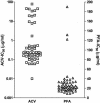ELVIRA HSV, a yield reduction assay for rapid herpes simplex virus susceptibility testing
- PMID: 15155247
- PMCID: PMC415590
- DOI: 10.1128/AAC.48.6.2331-2333.2004
ELVIRA HSV, a yield reduction assay for rapid herpes simplex virus susceptibility testing
Abstract
A colorimetric yield reduction assay, ELVIRA (enzyme-linked virus inhibitor reporter assay) HSV, was developed to determine the antiviral drug susceptibilities of herpes simplex virus (HSV). It uses an HSV-inducible reporter cell line. This simple and rapid assay has an objective readout, low inoculum size, and good reproducibility. The results correlate well with those of the plaque reduction assay.
Figures



Similar articles
-
Rapid determination of antiviral drug susceptibility of herpes simplex virus types 1 and 2 by real-time PCR.Antiviral Res. 2006 Mar;69(3):152-7. doi: 10.1016/j.antiviral.2005.11.004. Epub 2005 Dec 19. Antiviral Res. 2006. PMID: 16388859
-
Antiviral activities of methylated nordihydroguaiaretic acids. 2. Targeting herpes simplex virus replication by the mutation insensitive transcription inhibitor tetra-O-methyl-NDGA.J Med Chem. 1998 Jul 30;41(16):3001-7. doi: 10.1021/jm980182w. J Med Chem. 1998. PMID: 9685239
-
Comparison of a DNA probe assay with the plaque reduction assay for measuring the sensitivity of herpes simplex virus and varicella-zoster virus to penciclovir and acyclovir.J Virol Methods. 1996 Jan;56(1):3-11. doi: 10.1016/0166-0934(95)01889-1. J Virol Methods. 1996. PMID: 8690764
-
[Resistance of herpes simplex viruses to antiviral drugs].Pathol Biol (Paris). 1993 Feb;41(2):172-7. Pathol Biol (Paris). 1993. PMID: 8392160 Review. French.
-
[Contribution of the laboratory in case of resistance to acyclovir of herpes simplex and varicella zoster virus].Ann Biol Clin (Paris). 2003 Jan-Feb;61(1):33-40. Ann Biol Clin (Paris). 2003. PMID: 12604384 Review. French.
Cited by
-
Genotypic characterization of UL23 thymidine kinase and UL30 DNA polymerase of clinical isolates of herpes simplex virus: natural polymorphism and mutations associated with resistance to antivirals.Antimicrob Agents Chemother. 2010 Nov;54(11):4833-42. doi: 10.1128/AAC.00669-10. Epub 2010 Aug 23. Antimicrob Agents Chemother. 2010. PMID: 20733037 Free PMC article.
-
Establishment of a cell-based assay for screening of compounds inhibiting very early events in the cytomegalovirus replication cycle and characterization of a compound identified using the assay.Antimicrob Agents Chemother. 2008 Jul;52(7):2420-7. doi: 10.1128/AAC.00134-08. Epub 2008 May 5. Antimicrob Agents Chemother. 2008. PMID: 18458124 Free PMC article.
-
Strategies for antiviral screening targeting early steps of virus infection.Virol Sin. 2010 Aug;25(4):281-93. doi: 10.1007/s12250-010-3135-z. Epub 2010 Jul 28. Virol Sin. 2010. PMID: 20960301 Free PMC article. Review.
-
Antiviral evaluation of octadecyloxyethyl esters of (S)-3-hydroxy-2-(phosphonomethoxy)propyl nucleosides against herpesviruses and orthopoxviruses.Antiviral Res. 2009 Dec;84(3):254-9. doi: 10.1016/j.antiviral.2009.09.012. Epub 2009 Oct 1. Antiviral Res. 2009. PMID: 19800369 Free PMC article.
-
A cell-based high-throughput approach to identify inhibitors of influenza A virus.Acta Pharm Sin B. 2014 Aug;4(4):301-6. doi: 10.1016/j.apsb.2014.06.005. Epub 2014 Jul 14. Acta Pharm Sin B. 2014. PMID: 26579399 Free PMC article.
References
-
- Chen, Y., C. Scieux, V. Garrait, G. Socie, V. Rocha, J. M. Molina, D. Thouvenot, F. Morfin, L. Hocqueloux, L. Garderet, H. Esperou, F. Selimi, A. Devergie, G. Leleu, M. Aymard, F. Morinet, E. Gluckman, and P. Ribaud. 2001. Resistant herpes simplex virus type 1 infection: an emerging concern after allogeneic stem cell transplantation. Clin. Infect. Dis. 31:927-935. - PubMed
-
- Danve-Szatanek, C., M. Aymard, D. Thouvenot, F. Morfin, G. Agius, I. Bertin, S. Billaudel, B. Chanzy, M. Coste-Burel, L. Finkielsztejn, H. Fleury, T. Hadou, C. Henquell, H. Lafeuille, M. E. Lafon, A. Le Faou, M. C. Legrand, L. Maille, C. Mengelle, P. Morand, F. Morinet, E. Nicand, S. Omar, B. Picard, B. Pozzetto, J. Puel, D. Raoult, C. Scieux, M. Segondy, J. M. Seigneurin, R. Teyssou, and C. Zandotti. 2004. Surveillance network for herpes simplex virus resistance to antiviral drugs: 3-year follow-up. J. Clin. Microbiol. 42:242-249. - PMC - PubMed
-
- Morfin, F., and D. Thouvenot. 2003. Herpes simplex virus resistance to antiviral drugs. J. Clin. Virol. 26:29-37. - PubMed
-
- Safrin, S., T. Elbeik, L. Phan, D. Robinson, J. Rush, A. Elbaggari, and J. Mills. 1994. Correlation between response to acyclovir and foscarnet therapy and in vitro susceptibility result for isolates of herpes simplex virus from human immunodeficiency virus-infected patients. Antimicrob. Agents Chemother. 38:1246-1250. - PMC - PubMed
MeSH terms
Substances
LinkOut - more resources
Full Text Sources

